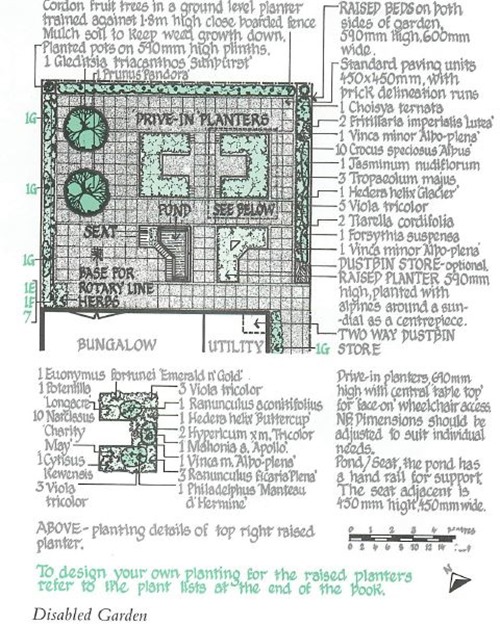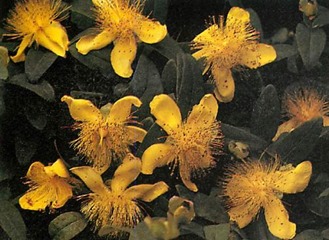





This attractive garden is suitable for those who are confined to a wheelchair. It has an interesting layout and aesthetically pleasing shape which are one hundred per cent practical, with consideration given to all the wheelchair gardener’s requirements.
The elegant layout is formal yet this garden is as rewarding for the garden lover who is able-bodied as for the garden lover who is not.
As you look out across the wide smooth paved garden from the bungalow, the main body of the garden is divided into four by four raised planters so the gardener can be surrounded by plants. The first quarter of these geometric-shaped raised planters to catch the eye is a welcoming seat with a rail to lean on and hold. The seat adjoins the raised planter, the back of which makes a small six-sided pond gracefully angled towards the house.
This geometric pond is mirrored on the opposite side of the wide obstacle-free path by another raised planter at a slightly higher level. This time a sundial makes an interesting feature in the corner of one of the four corners which point towards the centre. The yellow, cream and gold plants chosen for the planting plan will make this a bright and unusual garden.
 The last two sections at the rear which make up the last two quarters of the square are wonderfully enveloping. The planters are 2 ft 4 in (70 cm) high, suitable for driving the wheelchair right into the plant area with plenty of room for knees and feet. This enables the gardener to get in among the plants, as the ‘shelf bed at the ‘drive in’ point is designed so beds are literally over the gardener’s lap.
The last two sections at the rear which make up the last two quarters of the square are wonderfully enveloping. The planters are 2 ft 4 in (70 cm) high, suitable for driving the wheelchair right into the plant area with plenty of room for knees and feet. This enables the gardener to get in among the plants, as the ‘shelf bed at the ‘drive in’ point is designed so beds are literally over the gardener’s lap.
On the far side of the garden, nicely in view of the patio area, and catching most of the day’s sun, are two ornamental trees – Gleditsia Triacanthos ‘Sunburst’, which has delicate golden yellow leaves to enhance the garden with its burst of beautiful colour from spring to autumn, and Prunus ‘Pandora’. There is enough space between the trees for a bench if required, ideal for a quiet rest in the shade. The raised planters opposite the bench with their overhanging plants provide plenty to admire, or long to get one’s hands on, as the case may be.
The joy of having herbs in salads or sauces is well worth the little trouble involved. Nearly all herbs are trouble-free. The soft herbs such as chives, mint and parsley can be kept in pots on the kitchen window sill, or fairly easily reached in the raised planter on the left of the patio doors.
Hard herbs such as rosemary and sage can afford to be further away as they can be picked and dried and do not have to be fresh. So they are located in the sunnily positioned raised planter opposite the small pond.
There is a space for the dust bin on the far right hand side of the garden easily accessible for the obliging dustman to come down the side of the house. But if a disabled person is living alone, a two-way dust bin cupboard which can be reached from within the house and without, with a good lock on the inside, is ideally situated for dust bin collection.
A barbecue is a troublesome piece of paraphernalia for the disabled person living alone but, should it be needed, there is plenty of space to store a portable barbecue, as indeed there is for a clothes line.
Slabs of simulated York stone or concrete paving slabs can sometimes be uninteresting and severe if not relieved by the introduction of another material such as brick. Obviously for wheelchairs the surface should be as smooth as possible, so avoid too much detail, but runs of brick round the edge of the path to soften and enhance its appearance are worthwhile and do not need to be more expensive than paving slabs. Laying the bricks lengthways, thus using only half the number of bricks, helps to bring down the cost. Non-slip paving is essential in all gardens and most certainly for the disabled.
The boundaries of the garden can be well used to make a good support for cordon fruit trees in ground level planters at the far end of the garden. These should not prove too much trouble, especially if the roots are covered with a good mulch, avoiding the impossible task of weeding at below waist level. The fruit, on the other hand, is at exactly the right height for picking, pruning and training, and very tempting and enjoyable it will be too. The blossom of apple or pear is lovely in spring and will attract bees; and the fruit should be good to eat.
The two side walls can enjoy the company of sweet-smelling trouble-free shrubs such as choisya, which does not need pruning or training, or ‘Mermaid’ climbing rose which is also trouble-free and undemanding.
This practical and attractive garden should be a pleasure for the wheelchair-bound who want to get out and around to enjoy their garden.
Cream, yellow and gold colour scheme.
T = Trouble free
Gleditsia triacanthos ‘Sunburst’. Grows slowly to 18-25ft (5.5-8m). Spread 12-15ft (3.5-4.5m) but is easily pruned to keep it smaller. Small, very finely divided, light yellow/gold leaves in spring and summer, turning brighter yellow in the autumn. Delightful ‘sunny’ tree, which has an interesting, almost gnarled shape in winter when the leaves have fallen. Needs a sunny place but sheltered, as the wood is very brittle.
Prunus ‘Pandora’. A slender flowering cherry that grows to 16 ft (5m). The pale pink flowers come in early spring and the leaves turn orange in autumn.
T Mahonia aquifolium. Evergreen shrub. This mahonia is low-growing, reaching 3ft or more (1 m) and spreads a little by suckers to form a clump. Glossy dark green leaves and scented yellow flowers in March/April followed by blue/black berries. The leaves sometimes go dull purple/red in winter, especially in dry soils.
T Potentilla ‘Longacre’. A dense low-growing mat-forming deciduous shrub. It has pale sulphur yellow five-petalled flowers throughout the summer and mid-green foliage with five leaflets (hence its other name, Cinquefoil). Grows to I ft (30cm). Spreads to 3ft (90 cm). Other varieties are taller and not so spreading.
T Cytisus kewensis (Broom). Long slender weeping branches with small mid-green leaves and a profusion of pale yellow flowers in May. Ideal for flowing over the side of the raised planter. The green stems are also effective in winter. Height 12- 14 in (30-35cm). Spread 4ft (1.2m). Sun-loving.
T Ivy. Also to flow over the side of the planter and give year-round interest.
T Vinca minor ‘Albo-plena’ (Periwinkle). A good evergreen creeping weeping plant for shade. Double white flowers. March to fitly. Small dark shiny leaves. Height 2-4 in (5-10cm). Spread 3-4ft (90cm- 1.2m). Other varieties have blue or dark red single or double flowers and some have variegated leaves.
 T Hypericum X moseranum ‘Tricolor’ (St John’s Wort). Semi-evergreen. Green and white variegated leaves with red margins. This shrub will grow in any soil but will not tolerate shade. It has dazzling shiny yellow star-like flowers with a mass of golden stamens with orange anthers from June to September. This variety grows to 1ft-18 in (30-45 cm) with the same spread. This is a sun-loving Hypericum.
T Hypericum X moseranum ‘Tricolor’ (St John’s Wort). Semi-evergreen. Green and white variegated leaves with red margins. This shrub will grow in any soil but will not tolerate shade. It has dazzling shiny yellow star-like flowers with a mass of golden stamens with orange anthers from June to September. This variety grows to 1ft-18 in (30-45 cm) with the same spread. This is a sun-loving Hypericum.
T Rose Mermaid. Wonderful low-maintenance climber (almost evergreen especially in walled garden). Not prone to any of the usual rose pests. Delightful creamy yellow, single, open-faced flowers all summer. Fierce thorns but lovely shiny foliage. Rather vigorous and does not like regular pruning. Tolerates shade.
T Ranunculus ficaria ‘Plena’ (Celandine). Very low-growing herbaceous hardy perennial. Masses of small bright yellow gold flowers in February/March. The leaves die away by June so can be grown under deciduous shrubs.
T Miniature Daffodils ‘Charity May’. Grows to a height of Win (25cm) and has pure yellow flowers in March/April.
T White Pansies. Crocus speciosus ‘Albus’. October flowering crocus.
T Viola tricolor (Heartsease). Sweet purple, yellow and violet flowers. Height 2—6 in (5— 15cm). Spread 8-12 in (20-30cm). Flowers May to September.
T Ranunculus aconitifolius. Tuberous rooted perennial. Height 2ft (60cm). Spread 1ft- 18in (30-45cm). Mid-green leaves. Unusual border plant, likes half sun, half shade. A profusion of delicate small white flowers in May and June. Can be difficult to obtain.
T Philadelphia ‘Manteau d’Hermine’ (Dwarf mock orange blossom). Height 2-3ft (60-90cm). Spread 2—3ft (60-90cm), liny, double, heavily scented white flowers in June and July. Small, mid-green, prominently veined leaves cover this bushy shrub. Prefers sunny position.
T Tiarella cordifolia (Foam flower). Most useful evergreen perennial ground cover. Excellent in shade and beneath trees. Height 1ft (30cm). Slightly furry mid-green maple-shaped leaves which form clumps. Feathery white flowers on thin spikes from spring to summer. Shade-loving.
One raised planter could be devoted to an alpine garden by adding rocks and pebbles and small alpine plants can be planted in the joints of the brickwork providing the mortar has been omitted.
T Convallaria majalis (Lily of the valley). Hardy herbaceous perennial. Delightful sweet smelling small white flowers in May. Long slim mid-green leaf Height 10 in (25 cm). Lily of the valley can be planted all along the low retaining wall beneath the Mermaid Rose. Lovely as cut flowers.
Jasminum nudiflorum (WinterJasmine). Deciduous climber. Grows to 10ft (3 m). Yellow flowers on naked green branches in winter to brighten up the dark months. Tiny oval green leaves.
Forsythia suspensa. Height 8-10 ft (2.5-3 m). Rambling shrub, excellent against a wall. Mid-green leaves. Yellow flowers March and April. Prune after flowering.
Hedera helix ‘Glacier’ (Variegated ivy) next to Forsythia. Vigorous grey leafed variegated ivy climber.
Fritillaria imperialis ‘Lutea’ or ‘Lutea Maxima’ (Crown Imperial). Impressive plant if you can stand the foxy smell of bulb when planting or when in flower each spring. Height 2-3ft (60-90cm). Long stout stems with terminal tufts of bright green slim leaves and yellow pendant bell-like flowers in early spring. For best results plant the bulbs on their side otherwise the water gets into the hollow crown and, if you are sensitive to smell, not too near the house!
Other plants with white or yellow flowers for the disabled garden:
Nasturtium
Forsythia
Dogwood – Cornus alba elegantissima
Jasminum officinale
Cordon fruit trees
Camellias
Choisya
Bulbs (cream and yellow tulips)
Dwarf Azaleas (white)
Crown Imperial (height 2 ft/60 cm) for under fruit trees
Copyright © www.100flowers.win Botanic Garden All Rights Reserved